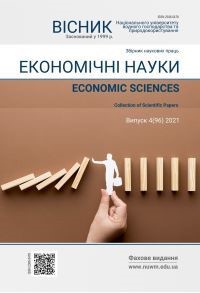COMMUNICATION WITH STAKEHOLDERS IN THE PROJECT OF DEVELOPING STRATEGIC COMMUNITY STRATEGIC DOCUMENTS
DOI:
https://doi.org/10.31713/ve420218Keywords:
strategic development project, data visualization, strategic communications, socio-economic development program, strategic analysis.Abstract
With the completion of administrative reform, local communities have needed quality strategy. The process of developing strategic documents of territorial communities is rather slow. The analysis of the sites of territorial communities of Rivne region showed that 18 out of 64 territorial communities have development strategies, which is 28%. Programs of socioeconomic development of territorial communities, although they are documents, the availability of which is a prerequisite for financing expenditures from the local budget, could be found only on the websites of 11 territorial communities. In territorial communities where development strategies have been developed, these documents rarely play their main role - they become real guidelines for strategic development of communities, which assess the effectiveness of local governments. The peculiarity of projects for the development of strategic documents of local communities is that they require significant involvement of stakeholders in the initiation, development, monitoring and evaluation of results. This requires the establishment of a quality system of interaction with stakeholders, using a wide arsenal of methods and tools for dissemination and collection of information. However, as the analysis of the sites of territorial communities of Rivne region showed, only in Krupetsk territorial community there is a communication strategy. In other territorial communities such documents are absent.The success of such projects largely depends on the following tasks: 1. Actualization of the problem solved by the project in different targetgroups.2. Involvement of stakeholders in the project implementation process. 3. Involvement of stakeholders in project monitoring, verification and evaluation.An important step towards solving these tasks is to build a clear system of indicators for achieving the results of the strategy or program. The methodological basis of such a system of indicators should be the Theory of Change, which provides for the decomposition of key results of a strategy or program of socio-economic development according to the logic of the «chain of change»: Impact-Outcome-Output-Input. The beneficiaries of the results, and therefore the objects of interaction, will be different target groups and beneficiaries. Each level of indicators in the chain of change requires the use of an appropriate set of methods and tools for communicating with stakeholders. For example, it is advisable to communicate with Impact-results and Outcomes-results with all residents of the community, using the community website, reports on the implementation of strategic documents. It is advisable to present information in a simple and understandable form for residents, using a variety of visualization tools. Users of information about Inputs-results and Outputs-results will be target groups that are directly involved in the processes of obtaining these results. Even if it is distributed to the community, it will be of little use. Conversely, this will lead to a loss of interest in the strategic documents of the local community.Stakeholders play a key role in monitoring and evaluating the implementation of local community development strategies and programs, as they are directly involved in monitoring and evaluation processes. Monitoring and evaluation can be organized and conducted by local governments or non-profit organizations. The selection of methods and tools for disseminating monitoring information should be such as to ensure maximum dissemination of information to different groups of the population.References
Про засади державної регіональної політики : проект Закону про внесення змін до Закону України. URL: http://w1.c1.rada.gov.ua/pls/zweb2/webproc4_1?pf3511=71562 (дата звернення: 20.12.2021).
Бриль М. Стратегія – основа становлення та розвитку ОТГ. Місцеве
самоврядування. URL: https://i.factor.ua/ukr/journals/ms/2018/may/issue-5/article-36538.html (дата звернення: 20.12.2021).
Беззубко Б. Б. Проблеми сучасного етапу стратегічного планування розвитку територіальних громад у Донецькій області. Економічний вісник Донбасу. 2018. № 2(52). С. 17–20. URL: https://cyberleninka.ru/article/n/problemi-suchasnogo-etapu-strategichnogoplanuvannya-rozvitku-teritorialnih-gromad-u-donetskiy-oblasti/viewer (дата звернення: 20.12.2021).
Крайник О. Складові економічного розвитку територіальної громади. Ефективність державного управління: у 2 ч. 2019. Вип. 2(59). Ч. 2. С. 165–176. URL: http://edu.lvivacademy.com/article/view/178434 (дата звернення: 20.12.2021).
Kurushina E. V. Performance Criteria of Spatial Development Projects Based on Interregional Integration. Economy of region. 2018. С. 176–189. URL: http://www.economyofregion.com/archive/2018/68/3018/ (дата звернення: 20.12.2021).
Kuklin A. A., Korobkov I. V. URL: http://www.economyofregion.com/archive/2018/71/3104 (дата звернення: 20.12.2021).
Jonas Söderlund, Jörg Sydow. URL: https://www.sciencedirect.com/science/article/abs/pii/S0263786319300146 (дата звернення: 20.12.2021).
Julian Kopmann, Alexander Kock, Catherine P Killen, Hans Georg Gemünden. URL: https://www.sciencedirect.com/science/article/abs/pii/S0263786317302041 (дата звернення: 20.12.2021).
Raymond Young, Michael Young, Ernest Jordan, Paul O'Connor. URL: https://www.sciencedirect.com/science/article/abs/pii/S0263786312000452 (дата звернення: 20.12.2021).
Project Management Institute.The Standard for portfolio management–Fourth Edition Available. URL: https://www.pmi.org/pmbok-guidestandards/foundational/standard-for-portfolio-management/fourth-edition (дата звернення: 20.12.2021).
Results-based management in the United Nations system high-impact model for results-based management. Benchmarking framework, stages of development and outcomes. United Nations, Geneva. Available. URL: https://www.unjiu.org/sites/www.unjiu.org/files/jiu_note_2017_1_english_0.pdf (дата звернення: 20.12.2021).
Горошко А. Нарчинська Т., Озимок І., Тарнай В. Глосарій термінів з моніторингу та оцінювання. 2-ге видання. Київ : ФОП Філімончук М. М., 2016. 56 с.

